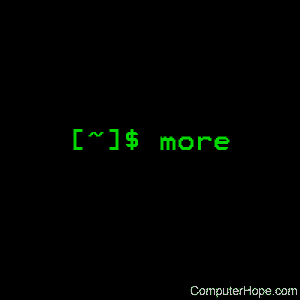How To Send A Command To The Background In Linux
Linux more control
Updated: 11/06/2021 by Reckoner Promise

On Unix-like operating systems, the more command displays text, one screen at a time.
This page covers the GNU/Linux version of more.
Clarification
more is a filter for paging through text one screen at a time. It does not provide as many options or enhancements every bit less, but is still quite useful and simple to use.
Syntax
more than [-dlfpcsu] [-num lines] [+/pattern] [+linenum] [file ...]
Options
| -num lines | Sets the number of lines that makes upwardly a screenful. The lines must be an integer. |
| -d | With this option, more prompts the user with the message "[Press space to proceed, 'q' to quit.]" and display "[Press 'h' for instructions.]" when an illegal key is pressed, instead of ringing a bell. |
| -fifty | more usually treats ^L (Control-50, the class feed) equally a special graphic symbol, and pauses after whatever line containing it. The -l selection prevents this behavior. |
| -f | Causes more than to count logical, rather than screen lines (i.east., long lines are not wrapped). |
| -p | Practice non scroll. Instead, clear the whole screen and then display the text. This option is switched on automatically if the more executable is named page. |
| -c | Practise not scroll. Instead, pigment each screen from the acme, clearing the remainder of each line equally it is displayed. |
| -s | Squeeze multiple bare lines into one bare line. |
| -u | Practice not display underlines. |
| +/ string | Search for the string cord, and advance to the commencement line containing string when the file is displayed. |
| + num | Starting time displaying text at line number num. |
Commands
When displaying a file, more can be controlled with a set of commands loosely based on the text editor vi. Some commands can be preceded by a decimal number referred to as k in the following descriptions.
| h, ? | Show help (display a brief control summary). If you lot forget all the other commands, call back this i! |
| [k]Infinite | Pressing the spacebar displays the adjacent yard lines of text. If thou is not specified, more displays a total screen of new text. |
| [m]z | Like pressing SPACE, only m becomes the new default number of lines to display. |
| [yard]RETURN | Pressing the Enter or Return key displays next yard lines of text. The default is i line. If specified, k becomes the new default. |
| [k]d, [k]^D | Pressing d or CONTROL-D scrolls 1000 lines. The default is the electric current roll size, which is initially 11 lines. If specified, thousand becomes the new default. |
| q, Q, ^C | Pressing q, Q, or CONTROL-C (the interrupt cardinal) exits the program. |
| [k]s | Skip forward one thousand lines of text. Defaults to one. |
| [g]f | Skip forward k screenfuls of text. Defaults to ane. |
| b, ^B | Pressing b or CONTROL-B skips backward k lines of text. Defaults to 1. (This simply works when viewing files, not piped input). |
| ' | Get to the place where the previous search started. |
| = | Display the current line number. |
| [thousand]/ blueprint | Search for the thouth occurrence of the regular expression pattern. Defaults to 1. |
| [yard]due north | Search for the kth occurrence of the last regular expression searched for, which defaults to 1. |
| ! command, :! command | Execute command in a subshell. |
| v | Start up an editor at current line. The editor is taken from the environment variable VISUAL if it's defined, or EDITOR if VISUAL is undefined; if neither is defined, defaults to "vi". |
| ^L | Pressing CONTROL-50 redraws the screen. |
| [g]:n | Go to the gth next file. Defaults to i. |
| [thousand]:p | Go to the kth previous file. Defaults to i. |
| :f | Brandish the current file name and line number. |
| . | Echo previous command. |
Environment
more uses the values of the following environment variables, if they are defined:
| MORE | Default more options. If this variable is fix, more reads as the default fix of options to use. Any options specified on the command line override the options specified in $More. |
| SHELL | The electric current beat in utilize (this variable is normally set past the vanquish itself at login time). |
| TERM | The current terminal type. This value is used by more to determine the proper way to dispense the screen. |
Examples
more +three myfile.txt
Display the contents of file myfile.txt, beginning at line iii.
more than +/"hope" myfile.txt
Brandish the contents of file myfile.txt, beginning at the first line containing the string "hope".
ls | more
Listing the contents of the electric current directory with ls, using more to display the listing one screen at a time.
cat — Output the contents of a file.
csh — The C shell command interpreter.
ctags — Create tag files for source code.
less — Scrolling text viewer.
man — Brandish the transmission page of a given command.
nroff — Format documents for terminal display or line-printer.
script — Tape everything printed on your screen.
sh — The Bourne beat command interpreter.
ul — Translate underscores to underlining.
How To Send A Command To The Background In Linux,
Source: https://www.computerhope.com/unix/umore.htm
Posted by: ingramshament.blogspot.com


0 Response to "How To Send A Command To The Background In Linux"
Post a Comment